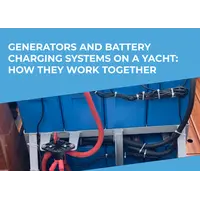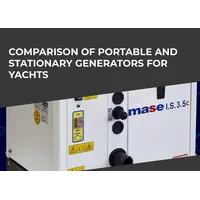We continue to talk about yacht's electrics: this time topRik experts share their own experience of using different types of chargers. From this article, you will learn about the pros and cons of automatic (digital) and manual (analog) chargers for traction and starting batteries on a yacht.
In the topRik marketplace you can buy different types of marine chargers from the world's best manufacturers of marine electrical equipment such as Ultimatron France, Mastervolt, Quick SpA., Victron Energy and others.
The charger’s principle of operation is simple. AC voltage is fed to the transformer, which reduces it to a level close to the battery voltage. Then the rectifier converts the voltage to DC, the filter reduces pulsations, and the regulator maintains the voltage at a given level. There are many ways to combine these components in one device.
For the starter and additional batteries on a small yacht or boat, a sealed charger with two outputs is suitable. Since the starter battery is almost always fully charged, and the service battery on small boats is most often a battery with liquid electrolyte with a capacity of 100 Ah, then a model with a current of 10 A is enough to charge both.
The device can be installed anywhere on the boat, without worrying about water or strong vibrations damaging it. The charger is fully automatic, and does not have any settings or adjustments. After charging is complete, the device reduces the voltage to 13.3 volts and can remain connected to the battery for as long as desired.
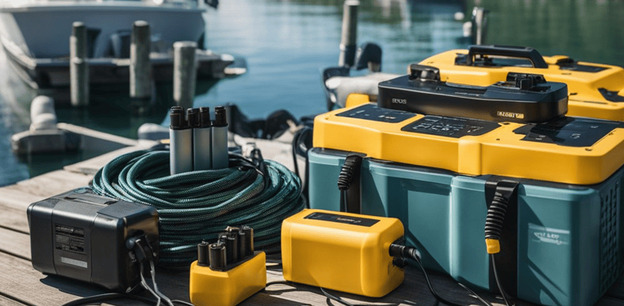
The system will remain incomplete if you do not provide for charging the second battery from the engine generator. The most common way to do this is a relay that automatically connects the service battery after the voltage on the starting battery increases to 13.3-13.5 volts (this means that the engine generator is working).
However, in this case, it is not necessary to use an expensive, voltage-sensitive relay. The charger has two outputs, the current between which is distributed proportionally to the load, so during charging on the shore, the relay can remain open. On the water, the relay will close the contacts and connect the second battery after voltage from the ignition switch arrives at its input connector.
On boats and yachts with bow electric motors, as a rule, two or three batteries are used, one of which has a voltage of 24 or 36 volts, and the other two - 12 volts. From the 220 volt network, all batteries are charged by one device with several outputs. However, this option is not the most optimal either in terms of cost and charging efficiency.
Instead of one, it is more convenient to use two chargers: one AC-DC (220-12 V) and one DC-DC (12-24 or 12-36 V). Together, they will allow you to charge all batteries both from the shore network and from the boat engine generator. Moreover, in this case, the batteries can be of different types - liquid-acid and gel or liquid-acid and LiFePO4, etc. It is important that the cost of a universal kit is lower than the cost of a charger with several outputs.
Most chargers for boat electric motors have a single charging voltage of 14.4 volts. This is suitable for gel and sealed batteries with liquid electrolyte. However, it does not meet the manufacturer's recommendations for serviced liquid-acid, some AGM and calcium batteries. They require 14.6-15.1 volts.
Low voltage is a common cause of undercharging. Due to incomplete charging, lead sulfate, which forms in the battery plates during discharge, hardens over time and forms large crystals that are difficult to convert back into active material. This process, known as sulfation, reduces the battery's capacity and slowly kills it.
There are several reasons for sulfation, but two of them are directly related to incorrect charging voltage:
- the battery is regularly undercharged, and part of the active material of the plates constantly remains uncharged;
- in the internal areas of thick plates or in plates with dense active material, chemical reactions do not proceed intensively enough.
For larger cabin boats and sailing yachts, the level of protection of the charger is not critical. Vessels in this class usually have a common negative bus, are equipped with shore power connections, and sometimes use an additional generator or sine wave inverter. The DC electrical system on most of them is 12 volts, but some may have 24 or 36 volts.
The charger in such boats is located in the engine compartment and its waterproofness is not of decisive importance. It is important that it is powerful, lightweight, has a remote control and can quickly charge several groups of batteries.
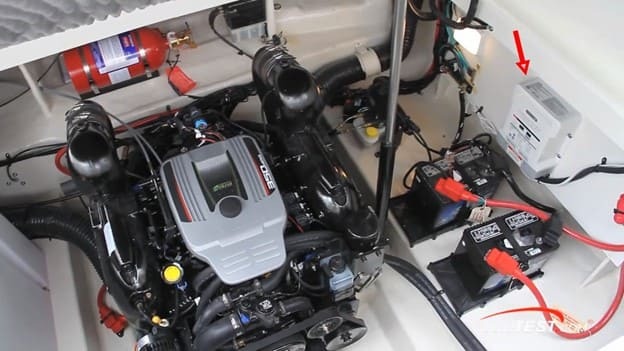
Large yachts are equipped with two or three groups of batteries. The total capacity of the batteries varies from boat to boat, but is usually 200-500 Ah. A battery of this size requires a powerful charger, which is difficult to operate manually.
The control of the charger can be analog or digital, that is, it can be controlled manually, or the control and switching between stages of charging the batteries can be entrusted to the microcontroller and the corresponding operating system.
Automatic Chargers
Digital or automatic chargers are indispensable on large yachts, which are equipped with various navigation systems and a significant number of devices and gadgets that provide the crew with basic and additional comfort. The latter include video and audio systems, kitchen equipment, boilers, heating, ventilation, air conditioning systems, etc. Agree that manually monitoring the charge level of batteries, which can also be installed in different parts of the boat, is quite difficult. And errors in monitoring are fraught with overcharging or undercharging of batteries, as well as failure of the alternator. Digital chargers will successfully save you from these troubles.
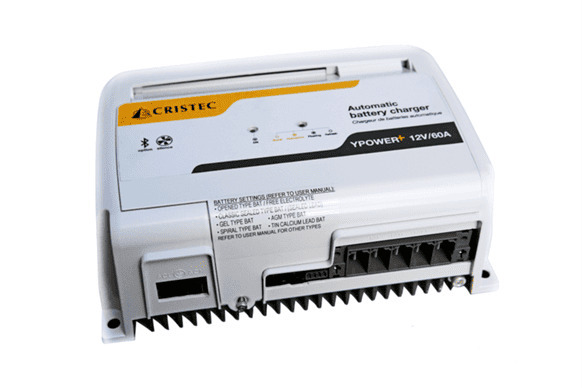
Operating Principle
In digital models, the operation is controlled by a microcontroller with a built-in analog-to-digital converter. The controller performs diagnostics of the device, converts input signals into digital form and, depending on them, changes the output parameters. Microcontrollers are good at performing sequential events or actions related to each other in time, such as charging in several stages.
Main Functions and Features
Individual charging programs for any batteries can be recorded in the memory of the microprocessor device. However, in practice, intelligent chargers implement similar algorithms.
One of the main functions of such a device is automatic switching between charging stages. The process of charging the battery consists of the saturation stage, absorption and maintenance charging. Some models provide for the equalization of liquid-acid batteries and desulfation mode.
Good models allow you to create charging profiles and set voltages at key points yourself. However, as a rule, they already have 5-10 charging programs for all common types of batteries - gel , AGM, liquid-acid or lithium.
Pulse chargers have a high power factor and are not sensitive to frequency and input voltage fluctuations. They operate stably at voltages from 110 to 270 volts and at frequencies of 45–70 Hz.
If the charger is connected to a low-power generator, voltage surges or frequency fluctuations will not affect its performance and will not affect battery charging.
Reliable protection against overcharging will save not only the batteries, but also the autonomous generator.
Advantages of Automatic Chargers
Digital, automatic, or smart chargers have many advantages over manually operated models.
- Low power consumption. The electrical system operates mostly from batteries, which serve as a buffer between consumers and the charger. The charger is only switched on when the battery voltage drops below a specified level.
- The temperature sensor and operating modes for each type of battery allow you to accurately select the charging algorithm for any battery. As a result, expensive batteries are charged more fully, are properly maintained and last longer.
- Several chargers can be installed in parallel. This allows for an easy increase in charging current and battery capacity.
- Two modes of operation - battery charging and power supply. With the charger, the on-board equipment will work even if there are no batteries.
- Remote control panel. The operation of the charger can be controlled even if it is installed in a hard-to-reach place.
- Output voltage ripple is 2-3%, which is safe for electronics and batteries.
- Optimize charging to extend battery life.
- The charger can be kept connected to the battery at all times without risk of damage.
- Ease of use, safety for users and maintenance.
Let's consider these qualities using the example of smart chargers Victron Blue Smart and Phoenix Smart, which are presented in the topRik marketplace in several modifications.
In the penultimate versions of the program for these chargers, the user could already reduce the battery charging current and select one of three preset voltage profiles. The updated version additionally features a history log and the ability to create your own charging algorithm.
The information in VictronConnect is divided into tabs. Detailed historical data for the last 40 battery charge cycles is located on the HISTORY tab. Each battery charge is shown here as a column. By clicking on any of them, you can find out how long the battery was charged and how many ampere-hours it received as a result.
Additional information is displayed in several lines below each column:
- Status – shows whether charging was completed completely or the device was turned off before it was finished;
- Elapsed – time elapsed from the beginning to the end of charging (the end of charging is considered to be the transition of the device to the Float stage or its shutdown);
- Charge – the number of ampere-hours received by the battery during stages 1 and 2 of charging (Bulk and Absorption);
- Maintain – the number of ampere-hours received by the battery after the device has switched to the recharging phase (Float and Storage stages);
- Type – the charging profile that was used during charging;
- Vstart – battery voltage before charging begins (voltage significantly less than 12 Volts indicates that the battery was too deeply discharged);
- Vend – battery voltage at the end of charging. If the process was interrupted before the battery was fully charged, two dashes will appear on the screen;
- Totals – the results of the device’s operation. The second line of this section is of the greatest interest, as it displays the number of started and fully completed charging cycles. It helps to understand how regularly the battery is charged to 100%.
Since undercharging leads to sulfation and loss of capacity of the lead-acid battery, then by monitoring the charging process, the owner can easily extend the service life of the battery. For LiFePO4 batteries, this information is also important. BMS (Battery Management System) balances the lithium cells at the end of the charge cycle, so in some operating modes you also need to know if the battery is charging to 100%.

Victron chargers Blue Smart has three pre-installed charging algorithms that are suitable for most lead-acid and LiFePO4 batteries. The user simply needs to select the one that matches the type of battery. The Normal algorithm is suitable for gel and AGM batteries, High is suitable for traction batteries with liquid electrolyte, and Li-ion is suitable for LiFePO4.
However, the new version of VictronConnect allows you to perform more precise adjustments to the charger. In the program, you can set your own absorption, conditioning, maintenance (storage) and desulfation voltage, as well as adjust the voltage compensation value when the temperature changes.
Expert mode of the application allows you to change almost any parameters, including the duration of each stage and the total duration of battery charging.
In order for the settings made in the app to be reflected in the charger, you need to connect your phone to it and update the firmware. After that, the waterproof chargers Victron IP67 12/25 and Victron IP67 24/12 get the same set of features as much more expensive models.
Phoenix Modifications Smart provides even more advanced adaptive, intelligent and dynamic charging functions.
Disadvantages of Automatic Chargers
Despite the advancement of digital chargers, some may be put off by their cost, which is higher than that of manual chargers.
Very experienced yachtsmen with special skills in electrical engineering may not be satisfied with the limitations in fine tuning.
And, as mentioned above, some chargers may not be compatible with certain types of batteries.
Handheld Chargers
Analog or manual chargers are cheaper, but their efficiency is far from maximum. Due to their limited capabilities, these devices are most often used to charge inexpensive batteries or in cases where a single charging algorithm is sufficient.
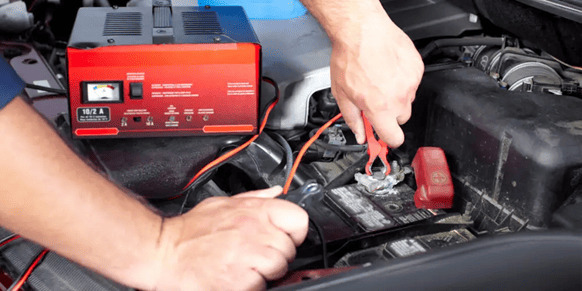
Operating Principle
The operating principle of a manual charger is the basis of automatic models, that is, it is largely similar for both types of chargers - analog and digital. The difference is that the owner of an analog model of a charger must monitor the charging of batteries independently.
To replenish the capacity of lithium iron phosphate traction batteries, CC/CV chargers are used. At first, the batteries are recharged with direct current, and the voltage on the cells increases. But when it reaches the upper limit of 3.65 volts per cell, the voltage growth stops, and the charging current drops to a minimum. At this stage, the batteries receive the final 5-10% of the charge.
This method of recharging allows the power elements to fully replenish their capacity without the risk of overcharging. Partial charges are not dangerous for lithium batteries, but full charge cycles should be carried out periodically to avoid reducing capacity.
Already at the first stage, manual chargers are inferior to “smart” digital models, which, before each charging process, use short voltage pulses to determine the state of the batteries and begin charging them from the required stage.
Main Functions and Features
However, despite all their simplicity, manual boat battery chargers in their modern interpretation are no longer the most primitive equipment. They have a high-water protection class (IP 67 and IP 68), as they are often installed directly in the cockpit.
As noted above, modern models use a two-stage charging algorithm (constant current - constant voltage), and also have:
- built-in protection against high output voltage and output current overload;
- protection against short circuit at the output, reverse polarity at the output;
- protection against high temperature of the charger;
- LED indicators located on the body;
- possibility of power adjustment.
Advantages
Budget yachtsmen will be able to appreciate the advantages of manual models, since their cost is significantly lower than that of automatic chargers.
Boaters who are well versed in electrical engineering will appreciate the ability to use the flexibility of the settings, which will allow them to manually control the battery charging process.
Flaws
For those who do not know the principles of operation of electrical equipment, manual chargers can be a problem. After all, they will have to constantly monitor the charging process and, if necessary, always be ready to intervene in the operation of the device.
There is a very high risk of overcharging or undercharging if the owner enters incorrect settings.
Hand-held models have far fewer built-in protection features, which can cause damage not only to batteries, but also to other electrical equipment that they power.
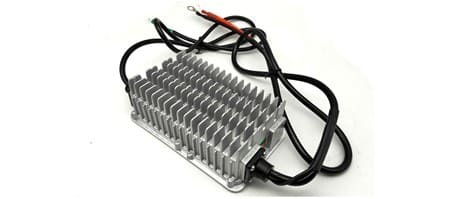
Which Charger to Choose: Automatic or Manual
To choose the right charger model, you must first answer the following questions:
- What electrical equipment is used when a yacht or boat is at the pier?
- What current does the vessel consume when the lights are fully on and the electrical equipment is working?
- What is the voltage in the electrical system - 12, 24 or 36 volts?
- Is there an inverter? If yes, what is its power?
- How many batteries are installed and what is the capacity of each one?
Let's assume that the boat's electrical system operates at 12 volts. At the mooring, 10 lamps are lit, each consuming 1 Amp of current. In addition to the lamps, the radio, satellite TV, and refrigerator are always on. The battery capacity is 100 Ah.
In this case, the current consumption is about 20 amperes. To charge the battery, you need at least another 10 A. So, a charger with an output current of 30 amperes will do.
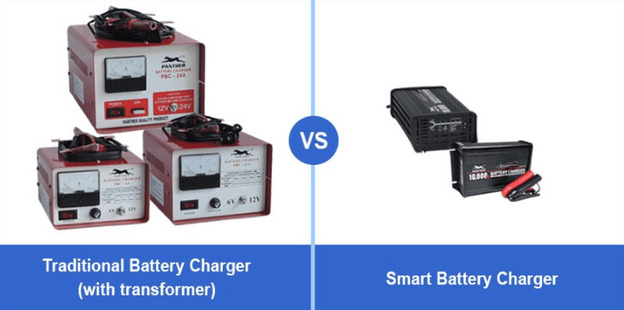
First of all, before buying a manual charger for a small boat or yacht, which is usually installed in the cockpit, that is, in an open place, it is necessary to choose the level of protection of the device from water and dust. Resistance to environmental influences is characterized by the protection class, which was developed by the International Electrotechnical Commission for the classification of housings of electrical devices. Ingress Rating Protection (IP) is useful when choosing a charger. The numbers following the letters IP in this classification correspond to the levels of tightness, which range from zero to complete protection from dust and water.
For example, IP65 means that the device is protected from dense dust for 2-8 hours and from water jets. However, some water may still get inside the case. But the IP67 protection standard means that the device can be submerged to a depth of 1 meter for 30 minutes without the risk of water penetration.
The next step is to select the power based on the desired charging time.
For boats and yachts that spend most of the week on the shore or in the dock and are constantly connected to the AC network, the charging time is not critical. The power of the charger in this case is chosen equal to 10 percent of the battery capacity. This is enough to charge the batteries for 8-10 hours.
But if the boat is used daily, then the charging time is important. There are several factors that affect the charging time.
- Battery efficiency. Liquid-acid batteries have an efficiency of about 80%. This means that during charging they need to transfer 120 Ah to get 100 during discharge. Gel , AGM and lithium batteries have an efficiency of 85-90%, and energy loss and charging time are shorter.
- Charging current. The higher it is, the shorter the charging time. For batteries with liquid electrolyte, manufacturers recommend a current of 10-20% of the capacity, for gel batteries - up to 25%. The highest permissible current is for AGM batteries: 30-50% C20. Lithium batteries are charged with a current of up to 100% of the capacity.
Below is a table showing in which cases a manual charger is sufficient, and when an automatic charger is preferable.
|
When to Choose an Automatic Battery Charger |
When to Choose a Manual Charger |
|
1. If you prefer simplicity in managing the yacht's electrical system. |
1. If you are an experienced electrician and prefer fine-tuning and personal control of the charger and battery condition. |
|
2. If you choose maximum safety for using and operating the vessel's electrical equipment. |
2. If you have the ability to constantly charge your batteries from shore power. |
|
3. If you are planning a long autonomous voyage. |
3. If you make irregular and short-term trips to sea. |
|
4. If you spend most of the navigation season at sea without calling at ports or marinas. |
4. If the boat's electrical equipment does not require high power to operate. |
|
5. If a significant part of the electrical equipment on board is constantly switched on. |
5. If you are confident in your ability to intervene in the charging process in order to make adjustments. |
|
6. If you want to ensure maximum comfort on board thanks to the ability to use household electrical appliances at any time. |
6. If you have a good knowledge of electrical engineering and strive to save money. |



